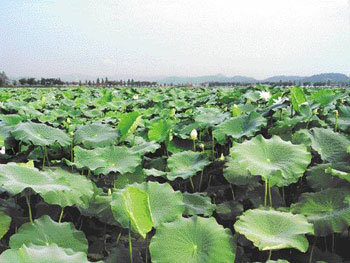Lotus Land

Muan, Jeonnam Province is the home of squid, lotus flowers, and the play, Pumba. Muan is a peninsula, a strip of ocher ditches, a complicated coastline, and muddy fields. This land of plenty is a glorious paradise of shore and ocean, and it was no coincidence that the lotus and Pumba became its symbol like they did.
Mornings in Muan begin with the sound of the seagulls riding the waves and lotus petals opening one by one. The lotus flower blooms from the mud, clean, honest, modest and fragrant. Its nickname, Gunja, which means the virtuous gentleman, fits it well. It is the flower Buddha held up in his thanks.
The lotus flowers cover 100,000 pyeong of Hoisan Baekryeonji (white lotus pond), and though the 10th Muan White Lotus Flower Festival has come and gone, it does not matter. The white lotus flowers, unlike the red ones, blossom well into September.
The Muan peninsula is a peculiar land formation that appeared as the high mountains of the east and low hills of the west submerged under the waters of the melted ice age. If the ocean had not risen, it would have been connected to a group of neighboring islets called Shinan.
Because the land is wet with the ocean, the coastline dips and turns. Foreshores and beaches are very much developed, and have wild names. Driving over this terrain, a novice is sure to get lost.
If you go into town, the sea is on either side of the railway. The left is Tandoman, and the right is Hampyeongman. The strip of land that connects the two resembles a tide embankment, and a famous tourist attraction, the Holtong, is here. Nowadays, one can catch many neon signs with Unjeori Bibimbab written on them, a kind of traditional local food.
The Holtong is a white-sand beach, windy enough for windsurfing. On the opposite side there is a protruding land mass, called the Dalmuri. The forests line a 400-meter coastline dotted with roped-in fishing boats, a coastline which used to be peaceful and sparsely populated, but is now bustling with tourists.
Jogeumnaru is a popular camping site, protruding with mud and sandy plains surrounded by foreshores. The suffix naru is for the naru boats that used to anchor in Jogeum because the tides left it untouched. A levee was built on the sands that allowed cars to roam over the land. Tando directly faces Jogeumnaru. The bay is filled with fishing boats and tents pack the area.
Illoeup is where Pumba, which reached its 4,000th performance, began in 1981. Residents got together in Cheonsa Village and performed their first play. Cheonsa Village, made in 1920, existed until the late 1980s, but became a ghost town and is now overrun with mugwort stalks and pokeweeds. Nearby is the birthplace of Pumba director Kim Shi-ra (deceased in 2000).
summer@donga.com







